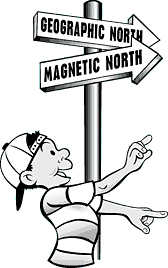|

Why does it matter what city I'm in?
What time it is depends upon where you are on the
planet. That's why you use a compass to orient yourself in this activity.
A compass needle (which is attracted to the magnetic field
of the earth) points in a direction called
magnetic north.
That isn't
exactly the same as
true north,
or
geographic north,
which
is the direction of the earth's North Pole. We've set up our Sun Clock so
that it uses geographic north as a reference point. If you don't line up
the diagram print-out with geographic north, the Sun Clock won't give you
the right time of day.
The difference between magnetic north and geographic north
is called
magnetic declination,
and it's different in different locations.
When you position the Sun Clock according to the directions on the diagram,
you are compensating for the magnetic declination of where you live. After
you do this, the "Geographic North" arrow at the top of the diagram
will be pointing to geographic north and your Sun clock will work just fine.
 What if my city is not on the list? Can I still use my Sun Clock?
What if my city is not on the list? Can I still use my Sun Clock?
If you aren't near any of the cities on the list,
you can still use the Sun Clock. Go out at night and look for the North
Star. (You may need a book of constellations to help you find it.) Mark
an arrow on the ground that points toward the North Star. That's geographic
north. The next day, position your print-out of the Sun Clock diagram with
the Geographic North arrow (in the top right-hand corner of the diagram)
pointing in the same direction that you marked on the ground (toward geographic
north). Now follow the rest of the instructions on the diagram.
How does a shadow tell time?
Shadows change direction, depending upon the time
of day. A Sun Clock like this one uses a shadow's position to tell the time.
Why doesn't the time on my Sun Clock exactly match the
time on my watch?
The time you get from your Sun Clock is solar time,
not standard time. The two aren't exactly the same.
According to
solar time,
it's noon when the sun
reaches its highest point in the sky. But the sun is always moving across
the sky--which means that noon where you are is at a slightly different
time than noon at a place a few miles to the east or west.
Back before 1883, people used solar time. Each community
kept its own time, basing that time on the sun's position in the sky. Back
then, noon in one town would be four minutes later than noon in a town fifty
miles to the east.
In 1883, to regulate time for the sake of railroad schedules,
the United States adopted what is called
standard time,
designating
time zones and requiring all communities within a time zone to keep the
same time--even though that standard time didn't quite match solar time.
If you are in the middle of your time zone, your Sun Clock
will be fairly accurate. If you are at one edge of your time zone, the time
on your Sun Clock (solar time) may differ from the time on your watch (standard
time) by as much as forty minutes.
Why do I have to put the pencil on different spots for
different times of the year?
The position and length of a shadow depends on
the time of day--but it also depends on the season of the year. That's because
the sun's position at a certain time of day is different in different seasons.
|